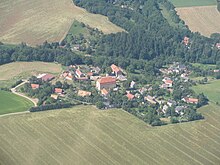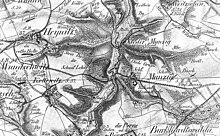Munzig
|
Munzig
Community Klipphausen
Coordinates: 51 ° 5 ′ 0 ″ N , 13 ° 25 ′ 0 ″ E
|
|
|---|---|
| Height : | 240 m above sea level NN |
| Residents : | 357 (December 31, 2011) |
| Incorporation : | 1st January 1973 |
| Incorporated into: | Burkhardswalde-Munzig |
| Postal code : | 01665 |
| Area code : | 035245 |
|
Location of the Munzig district in Klipphausen
|
|
Munzig is a district of the municipality of Klipphausen in the district of Meißen , Saxony .
geography
Munzig is located in the Meißner highlands between Wilsdruff , Nossen and Meißen . The village is surrounded by the other districts belonging to Klipphausen, Miltitz in the north-west, Roitzschen in the north, Weitzschen in the north-east, Seeligstadt in the east, Burkhardswalde in the south-east, Groitzsch and Perne in the south and Rothschönberg in the south-west. Neighboring to the west are the Nossen districts of Kottewitz and Heynitz .
Munzig is divided into Obermunzig and Niedermunzig, which are located in a common area and are connected by the street “Lämmerberg”. Obermunzig is located on the stream coming from Burkhardswalde or above it on the orographically right side of the valley slope. Niedermunzig is just under a kilometer to the northwest in the Triebisch valley . The Triebischtäler conservation area begins on the outskirts . In Diebsgrund, whose brook flows from the direction of Seeligstadt to Niedermunzig, the owner of the Munziger Pappenfabrik (see section Buildings and Facilities) had a landscape park laid out, through which a short nature trail now leads.
The most important street in the village is the valley or main street along the Triebisch, from which the Burkhardswalder Straße branches off. Other streets in Munzig are Bergstrasse, the “Bäckereiberg” and “An der Aue”. In its name, the Erzweg refers to the mining operations that were carried out in the area in earlier times. To the public transport Munzig is by the bus lines 413 and 418 of the transport company Meissen connected. The Borsdorf – Coswig line touches Munzig, but trains only stop in neighboring Miltitz.
Local history
The village was first mentioned in 1334 as "Munczig". In 1340 a "Jenchin von Muncik", in 1350 a "Ticzmannus de Munczk" appears in the documents, so that it is assumed that there was a manor house in the place at this time. Over the centuries, the place name changed, among other things via the stations "Muntzczigk", "Monzig" and "Nuntzke" to the current spelling, which is documented in 1791.
The development of the village began in today's Obermunzig. In 1457 there was a Vorwerk there . In the 15th century a manor developed around which Munzig was built as a manor settlement with a 198 hectare manor block corridor. The manorial rule and with it the higher and inheritance jurisdiction exercised in the 16th century members of the noble Miltitz family as owners of the manor of the same name. The old manor Munzig mentioned in 1696 and 1764 , to which in addition to Munzig itself also Weitzschen and Drei 30 near Mochau were subordinate, belonged to the noble family Ende until the beginning of the 18th century . It was then owned by the Kölbel family, then by the Schleinitz family until the beginning of the 19th century and by the Könneritz family until around 1860 , which was followed by various bourgeois owners until 1945. Munzig was parish after Burkhardswalde and therefore today belongs to the parish Burkhardswalde-Tanneberg.
For centuries, the administration of the place was incumbent on the Castrum or the Meißen hereditary office , where it was part of the Soppen Supania . In 1856 Munzig belonged to the Wilsdruff court office and then joined the Meißen district administration , from which the district of the same name emerged. On the basis of the rural community order of 1838 , Munzig gained independence as a rural community . On January 1, 1973 it merged with Burkhardswalde to form Burkhardswalde-Munzig , which in turn has been part of Triebischtal since March 1, 1994. With the incorporation of Triebischtal on July 1, 2012, Munzig is part of the municipality of Klipphausen.
Population development
| year | Residents |
|---|---|
| 1551 | 8 possessed men , 13 residents |
| 1764 | 7 possessed men, 18 cottagers |
| 1834 | 285 |
| 1871 | 288 |
| 1890 | 231 |
| 1910 | 358 |
| 1925 | 336 |
| 1939 | 398 |
| 1946 | 519 |
| 1950 | 500 |
| 1964 | 510 |
| 1990 | see Burkhardswalde-Munzig |
Mining history
Munzig is located in an old mining area; In the immediate vicinity are among others the Garsebacher Schweiz as the world's largest pitch stone deposit , the Miltitz and Groitzsch lime works and the mouth of the Rothschönberger Stolln . In Munzig itself, rock containing silver has been mined since 1514 , including galena , pyrites , pyrites , zinc blende , arsenic pebbles and limestone . The “Johanna-Erbstolln” and “Freundlicher Bergmann” pits were located on Diebsgrund, and the “Donat-Spat” and “Wilder Mann” mines at Weitzschen were also nearby.
Elector August had a smelter and a stamping mill built in 1580 . In 1715 silver ore was extracted from the “Freundlicher Bergmann” mine and delivered to the iron and steel works in Freiberg ; the yield between 1719 and the cessation of production in 1802 was about 382 kilograms of silver . The "Johanna Erbstolln ", driven from the entrance of the Diebsgrunds from 1759, served for drainage , in 1778 the "Dürrwiesner Stolln" took over this task. In the upper Diebsgrund various traces of the centuries of mining have been preserved, including pingen, heaps and remains of the dam that dammed up the stream in order to obtain drive water for the stamping mill.
Buildings and facilities
In the center of Obermunzig, on a ridge above the Triebischtal, is the manor house of the former manor. The two-storey baroque stucco building with mansard hipped roof was in 1743 at the site of a 1,571-mentioned Renaissance built -Vorgängerbauwerks and expanded in 1784 and 1822 (to its owners at this time see section history). After the expropriation and liquidation of the manor in 1945, the manor house served as a children's home . Among other things, the daughters of Jutta Gallus , who had been convicted of " illegally crossing the border ", were housed in it in 1982/83 . After the fall of the Berlin Wall, the manor house was given a new purpose as a social therapeutic rehabilitation center and residence for addicts. The manor house and the outbuildings were extensively renovated by 2001.
The Triebischtal cultural center is located in Niedermunzig, where mainly concerts and dance events take place. It was built around 1960 as the cultural center of the VEB Pappenfabrik Munzig and was used for leisure activities. It has largely been preserved in its original condition; the interior is still from the GDR era. In the Kulturhaus there is a large hall with a stage and a film projection room, a bowling alley, a sports and rehearsal room as well as boarding rooms.
The cardboard factory was the largest employer in Munzig; its successor company still exists today in a modified form. The Munziger grinding mill, which was bought and converted in 1892, was used to provide electricity. On former parts of their premises in Niedermunzig, there are now tracks for racing with radio-controlled model cars .
Several buildings in the village are protected as cultural monuments (see list of cultural monuments in Klipphausen # Munzig ).
Personalities
- Kurt Dämmig (December 13, 1884 in Munzig; † June 14, 1944 in Dresden), German sculptor
literature
- Cornelius Gurlitt : Munzig. In: Descriptive representation of the older architectural and art monuments of the Kingdom of Saxony. 41. Issue: Administrative Authority Meißen-Land . CC Meinhold, Dresden 1923, p. 316.
- Wolfgang Schanze: From the past days of silver mining near Munzig . Heimatkundliche Blätter District Dresden 3/1957, pp. 215–225
- Wolfgang Schanze: The last shift was long gone. Old mining between Triebisch and Elbe valleys. Klipphausen 2013
- Rudolf Schumann : On the old Silberstrasse from Scharfenberg and Munzig to Freiberg . Announcements of the Landesverein Sächsischer Heimatschutz 1939, pp. 97–123
Web links
- Munzig in the Digital Historical Directory of Saxony
- Munziger address book from 1888
- Mineral Atlas - Munzig mining area
Individual evidence
- ↑ archiv.sachsen.de ( page no longer available , search in web archives ) Info: The link was automatically marked as defective. Please check the link according to the instructions and then remove this notice.
- ↑ Municipalities 1994 and their changes since January 1, 1948 in the new federal states , Metzler-Poeschel publishing house, Stuttgart, 1995, ISBN 3-8246-0321-7 , publisher: Federal Statistical Office
- ↑ Klipphausen: Rittergut Munzig. In: Sachsens-Schlösser.de. Retrieved October 29, 2013 .
- ↑ race-center-munzig.de









